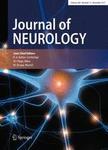版权所有:内蒙古大学图书馆 技术提供:维普资讯• 智图
内蒙古自治区呼和浩特市赛罕区大学西街235号 邮编: 010021

作者机构:Capital Med Univ Dept Cent Lab Xuanwu Hosp Beijing 100053 Peoples R China Jiangsu Prov Hosp 300 Guangzhou Rd Nanjing 210029 Jiangsu Peoples R China Hebei Med Univ Dept Neurol Hosp 1 Shijiazhuang 050030 Hebei Peoples R China Hainan Univ Sch Biomed Engn Haikou 570228 Hainan Peoples R China Beijing Inst Brain Disorders Ctr Alzheimers Dis Beijing 100053 Peoples R China Minist Educ Key Lab Neurodegenerat Dis Beijing 100053 Peoples R China Beijing Municipal Geriatr Med Res Ctr Beijing 100053 Peoples R China
出 版 物:《JOURNAL OF NEUROLOGY》 (J. Neurol.)
年 卷 期:2025年第272卷第2期
页 面:1-13页
核心收录:
基 金:Key Technologies Research and Development Program of Anhui Province [2021YFC2501205] National Key R&D Program of China [2021ZD0201101, 2022ZD0211800] STI2030-Major Project [YC202301QX0148] Beijing Translational Medicine Promotion Project National Nature Science Foundation of China
主 题:Alzheimer's disease A beta Circadian rhythm Cognitively impaired Blood-borne factors Pineal parenchymal volume
摘 要:Background Circadian disruptions are increasingly recognized in Alzheimer s disease (AD) patients and may influence disease onset and progression. This study examines how AD pathology affects blood-borne factors that regulate circadian rhythms. Methods Eighty-five participants from the Sino Longitudinal Study on Cognitive Decline were enrolled: 35 amyloid-beta negative normal controls (A beta- NCs), 23 amyloid-beta positive normal controls (A beta+ NCs), 15 patients with amnestic mild cognitive impairment (aMCI), and 12 with Alzheimer s disease dementia (ADD). Patients with aMCI and ADD were grouped as cognitively impaired (CI). Cellular circadian period length was assessed using a serum-based assay. Expression levels of clock genes in serum-treated cells and in leukocytes of participants were measured via real-time PCR. Plasma biomarkers were quantified using a single-molecule array immunoassay. Pineal parenchymal and hippocampal volumes were determined by magnetic resonance imaging. Results The cellular circadian period length was significantly extended by serum from CI patients than by that from A beta- NCs (p 0.01). Treatment of cells with serum from the CI patients resulted in suppressed expression of the clock genes Bmal1 and Nr1d1. Strong relationships between the expression levels of clock genes observed in leukocytes of the A beta- NC group did not appear in those of the A beta+ NC or CI groups. The significant correlation of cellular circadian period length and the pineal volume was only observed in the A beta- NC group, but not in the A beta+ NC or CI groups. Conclusions This study indicates the presence of significant changes in blood-borne factors that could affect the circadian rhythms in AD, starting even at preclinical stages. These alterations could precede cognitive decline and contribute to AD pathogenesis. Trial registrationThe cohort is registered at *** (SILCODE: NCT03370744;Registered on Mar 15th, 2017).